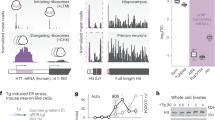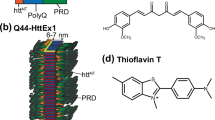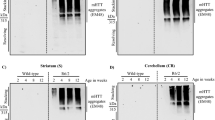Abstract
Huntington disease is one of nine inherited neurodegenerative disorders caused by a polyglutamine tract expansion. Expanded polyglutamine proteins accumulate abnormally in intracellular aggregates. Here we show that mammalian target of rapamycin (mTOR) is sequestered in polyglutamine aggregates in cell models, transgenic mice and human brains. Sequestration of mTOR impairs its kinase activity and induces autophagy, a key clearance pathway for mutant huntingtin fragments. This protects against polyglutamine toxicity, as the specific mTOR inhibitor rapamycin attenuates huntingtin accumulation and cell death in cell models of Huntington disease, and inhibition of autophagy has the converse effects. Furthermore, rapamycin protects against neurodegeneration in a fly model of Huntington disease, and the rapamycin analog CCI-779 improved performance on four different behavioral tasks and decreased aggregate formation in a mouse model of Huntington disease. Our data provide proof-of-principle for the potential of inducing autophagy to treat Huntington disease.
This is a preview of subscription content, access via your institution
Access options
Subscribe to this journal
Receive 12 print issues and online access
$259.00 per year
only $21.58 per issue
Buy this article
- Purchase on SpringerLink
- Instant access to full article PDF
Prices may be subject to local taxes which are calculated during checkout








Similar content being viewed by others
References
Rubinsztein, D.C. Lessons from animal models of Huntington's disease. Trends Genet. 18, 202–209 (2002).
Davies, S.W. et al. Formation of neuronal intranuclear inclusions underlies the neurological dysfunction in mice transgenic for the HD mutation. Cell 90, 537–548 (1997).
Saudou, F., Finkbeiner, S., Devys, D. & Greenberg, M.E. Huntingtin acts in the nucleus to induce apoptosis but death does not correlate with the formation of intranuclear inclusions. Cell 95, 55–66 (1998).
Gutekunst, C.A. et al. Nuclear and neuropil aggregates in Huntington's disease: relationship to neuropathology. J. Neurosci. 19, 2522–2534 (1999).
Dunah, A.W. et al. Sp1 and TAFII130 transcriptional activity disrupted in early Huntington's disease. Science 296, 2238–2243 (2002).
La Spada, A.R. & Taylor, J.P. Polyglutamines placed into context. Neuron 38, 681–684 (2003).
Chai, Y., Wu, L., Griffin, J.D. & Paulson, H.L. The role of protein composition in specifying nuclear inclusion formation in polyglutamine disease. J. Biol. Chem. 276, 44889–44897 (2001).
Ravikumar, B., Duden, R. & Rubinsztein, D.C. Aggregate-prone proteins with polyglutamine and polyalanine expansions are degraded by autophagy. Hum. Mol. Genet. 11, 1107–1117 (2002).
Webb, J.L., Ravikumar, B., Atkins, J., Skepper, J.N. & Rubinsztein, D.C. α-Synuclein is degraded by both autophagy and the proteasome. J. Biol. Chem. 278, 25009–25013 (2003).
Schmelzle, T. & Hall, M.N. TOR, a central controller of cell growth. Cell 103, 253–262 (2000).
Huang, S., Bjornsti, M.A. & Houghton, P.J. Rapamycins: mechanism of action and cellular resistance. Cancer. Biol. Ther. 2, 222–232 (2003).
Serkova, N. et al. Sirolimus, but not the structurally related RAD (everolimus), enhances the negative effects of cyclosporine on mitochondrial metabolism in the rat brain. Br. J. Pharmacol. 133, 875–885 (2001).
Supko, J.G. & Malspeis, L. Dose-dependent pharmacokinetics of rapamycin-28-n-n-dimethylglycinate in the mouse. Cancer Chemother. Pharmacol. 33, 325–330 (1994).
Kwon, C.-H., Zhu, X., Zhang, J. & Baker, S.J. mTOR is required for hypertrophy of Pten-deficient neuronal soma in vivo. Proc. Natl. Acad. Sci. USA 100, 12923–12928 (2003).
Wyttenbach, A. et al. Effects of heat shock, heat shock protein 40 (HDJ-2), and proteasome inhibition on protein aggregation in cellular models of Huntington's disease. Proc. Natl. Acad. Sci. USA 97, 2898–2903 (2000).
Schilling, G. et al. Intranuclear inclusions and neuritic aggregates in transgenic mice expressing a mutant N-terminal fragment of huntingtin. Hum. Mol. Genet. 8, 397–407 (1999).
Waelter, S. et al. Accumulation of mutant huntingtin fragments in aggresome-like inclusion bodies as a result of insufficient protein degradation. Mol. Biol. Cell 12, 1393–1407 (2001).
Kim, J.E. & Chen, J. Cytoplasmic-nuclear shuttling of FKBP12-rapamycin-associated protein is involved in rapamycin-sensitive signaling and translation initiation. Proc. Natl. Acad. Sci. USA 97, 14340–14345 (2000).
Fingar, D.C., Salama, S., Tsou, C., Harlow, E. & Blenis, J. Mammalian cell size is controlled by mTOR and its downstream targets S6K1 and 4EBP1/eIF4E. Genes Dev. 16, 1472–1487 (2002).
Wyttenbach, A. et al. Polyglutamine expansions cause decreased CRE-mediated transcription and early gene expression changes prior to cell death in an inducible cell model of Huntington's disease. Hum. Mol. Genet. 10, 1829–1845 (2001).
Kim, D.H. et al. GbetaL, a positive regulator of the rapamycin-sensitive pathway required for the nutrient-sensitive interaction between raptor and mTOR. Mol. Cell 11, 895–904 (2003).
Schwab, M.S. et al. p70(S6K) controls selective mRNA translation during oocyte maturation and early embryogenesis in Xenopus laevis. Mol. Cell. Biol. 19, 2485–2494 (1999).
Kegel, K.B. et al. Huntingtin expression stimulates endosomal-lysosomal activity, endosome tubulation, and autophagy. J. Neurosci. 20, 7268–7278 (2000).
Sapp, E. et al. Huntingtin localization in brains of normal and Huntington's disease patients. Ann. Neurol. 42, 604–612 (1997).
Kabeya, Y. et al. LC3, a mammalian homologue of yeast Apg8p, is localized in autophagosome membranes after processing. EMBO J. 19, 5720–5728 (2000).
Hennig, K.M. & Neufeld, T.P. Inhibition of cellular growth and proliferation by dTOR overexpression in Drosophila. Genesis 34, 107–110 (2002).
Manning, B.D. & Cantley, L.C. Rheb fills a GAP between TSC and TOR. Trends Biochem. Sci. 28, 573–576 (2003).
Jackson, G.R. et al. Polyglutamine-expanded human huntingtin transgenes induce degeneration of Drosophila photoreceptor neurons. Neuron 21, 633–642 (1998).
Franceschini, N. & Kirschfeld, K. Pseudopupil phenomena in the compound eye of drosophila. Kybernetik 9, 159–182 (1971).
Zhang, H., Stallock, J.P., Ng, J.C., Reinhard, C. & Neufeld, T.P. Regulation of cellular growth by the Drosophila target of rapamycin dTOR. Genes Dev. 14, 2712–2724 (2000).
Huang, S. & Houghton, P.J. Mechanisms of resistance to rapamycins. Drug Resist. Update 4, 378–391 (2001).
Elit, L. CCI-779 Wyeth. Curr. Opin. Investig. Drugs 3, 1249–1253 (2002).
Mangiarini L. et al. Exon 1 of the HD gene with an expanded CAG repeat is sufficient to cause a progressive neurological phenotype in transgenic mice. Cell 87, 493–506 (1996).
Lione, L.A. et al. Selective discrimination learning impairments in mice expressing the human Huntington's disease mutation. J. Neurosci. 19, 10428–10437 (1999).
Sathasivam, K. et al. Formation of polyglutamine inclusions in non-CNS tissue. Hum. Mol. Genet. 8, 813–822 (1999).
Rogers, D.C. et al. Behavioral and functional analysis of mouse phenotype: SHIRPA, a proposed protocol for comprehensive phenotype assessment. Mamm. Genome 8, 711–3 (1997).
Walpoth, B.H. et al. Prevention of neointimal proliferation by immunosuppression in synthetic vascular grafts. Eur. J. Cardiothorac. Surg. 19, 487–492 (2001).
British Medical Association and Royal Pharmaceutical Society of Great Britain. British National Formulary 4 (2003).
Kuemmerle, S. et al. Huntington aggregates may not predict neuronal death in Huntington's disease. Ann. Neurol. 46, 842–849 (1999).
Mizushima, N., Ohsumi, Y. & Yoshimori, T. Autophagosome formation in Mammalian cells. Cell Struct. Funct. 27, 421–429 (2002).
Gingras, A.C., Raught, B. & Sonenberg, N. Control of translation by the target of rapamycin proteins. Prog. Mol. Subcell. Biol. 27, 143–174 (2001).
Usdin, M.T., Shelbourne, P.F., Myers, R.M. & Madison, D.V. Impaired synaptic plasticity in mice carrying the Huntington's disease mutation. Hum. Mol. Genet. 8, 839–846 (1999).
Murphy, K.P. et al. Abnormal synaptic plasticity and impaired spatial cognition in mice transgenic for exon 1 of the human Huntington's disease mutation. J. Neurosci. 20, 5115–5123 (2000).
Yoo, S.Y. et al. SCA7 knockin mice model human SCA7 and reveal gradual accumulation of mutant ataxin-7 in neurons and abnormalities in short-term plasticity. Neuron 37, 383–401 (2003).
Tang, S.J. et al. A rapamycin-sensitive signaling pathway contributes to long-term synaptic plasticity in the hippocampus. Proc. Natl. Acad. Sci. USA 99, 467–472 (2002).
Steffan, J.S. et al. Histone deacetylase inhibitors arrest polyglutamine-dependent neurodegeneration in Drosophila. Nature 413, 739–743 (2001).
Ferrante, R.J. et al. Therapeutic effects of coenzyme Q10 and remacemide in transgenic mouse models of Huntington's Disease. J. Neurosci. 22, 1592–1599 (2002).
Hockly, E. et al. Suberoylanilide hydroxamic acid, a histone deacetylase inhibitor, ameliorates motor deficits in a mouse model of Huntington's disease. Proc. Natl. Acad. Sci. USA 100, 2041–2046 (2003).
Acknowledgements
We thank Wyeth Pharmaceuticals for the gift of CCI-779; G. Jackson for the fly model of Huntington disease; E. J. L. Maller and J. Chen for control and TOP luciferase vectors; N. Khan for brain samples from humans with Huntington disease and controls; A. Tobin for Gln25 and Gln103 constructs; H. Zoghbi for the ataxin constructs; W. J. Strittmatter for Gln19 and Gln81 constructs; K. L. Guan for rheb and FLAG-4E-BP1 constructs; T. Yoshimori for the antibody to LC3; A. Acevedo and E. Terrenoire for help with mouse brain samples; R. Padinjat for help with pseudopupil illumination; and M. Bobrow, D. Clayton and J. D. Cooper for helpful suggestions. We acknowledge funding from the Commonwealth Scholarship Commission for Ph.D. scholarship (B.R.), the Wellcome Trust for a Senior Clinical Research Fellowship (D.C.R.), a Senior Fellowship in Basic Biomedical Science (R.D.), a Prize Studentship (Z.B.), The Cambridge Overseas Trust (Z.B.), The Biotechnology and Biological Sciences Research Council for a Career Development Award (C.J.O.) and a Medical Research Council programme grant to D.C.R and S. Brown.
Author information
Authors and Affiliations
Corresponding author
Ethics declarations
Competing interests
The authors declare no competing financial interests.
Supplementary information
Rights and permissions
About this article
Cite this article
Ravikumar, B., Vacher, C., Berger, Z. et al. Inhibition of mTOR induces autophagy and reduces toxicity of polyglutamine expansions in fly and mouse models of Huntington disease. Nat Genet 36, 585–595 (2004). https://doi.org/10.1038/ng1362
Received:
Accepted:
Published:
Issue date:
DOI: https://doi.org/10.1038/ng1362
This article is cited by
-
A clinical study and future prospects for bioactive compounds and semi-synthetic molecules in the therapies for Huntington's disease
Molecular Neurobiology (2024)
-
Ferroptosis regulation through Nrf2 and implications for neurodegenerative diseases
Archives of Toxicology (2024)
-
The stress-responsive protein REDD1 and its pathophysiological functions
Experimental & Molecular Medicine (2023)
-
CRISPR/Cas9 Mediated Therapeutic Approach in Huntington’s Disease
Molecular Neurobiology (2023)
-
Vitamin B6, B12 and folate modulate deregulated pathways and protein aggregation in yeast model of Huntington disease
3 Biotech (2023)



